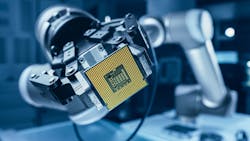Trends Driving ERP Expansion, Now and in the Future
It will come as no surprise to anyone watching tech trends that 2020 and the coming decade will see the enterprise resource planning (ERP) world take account of developments in Artificial Intelligence (AI), Machine Learning (ML), open APIs and cloud. But, new technologies are not the only trends that will influence ERP.
AI and ML is a pairing of technologies whose full potential has yet to be fully realized. In our November 2019 study we found 40% of manufacturers planned to implement AI for inventory planning and logistics, 36% for production scheduling and customer relationship management. Overall, 60% said they were targeting productivity improvements.
This reveals the scale of appetite for AI and ML because they can uncover fresh, innovative insights that boost the bottom line. Take the example of ‘just-in-time’ manufacturing. This is designed to deliver components at the last possible moment to alleviate storage and associated costs. If an AI is asked to look at just-in-time scheduling it can come up with a whole new approach to the production process, creating new options that can make a real difference and generate significant productivity gain.
Another big trend that is transformational for ERP, is open APIs. Based on open standards and easily made available to developers, open APIs are huge. They allow a wide range of client-side functions to be integrated into systems easily and quickly. They allow development to happen at pace because there are no hidden complexities, and they permit inbound and outbound connections to the digital core with the greatest possible flexibility and speed.
In addition, open APIs make it easy to connect to applications, platforms, services and databases that are external to the core. At IFS, we are fully committed to open APIs: They are the foundation of how our front-end works. That’s not changing for us, and we expect to see open APIs gain even more traction across the industry.
Cloud has been a trend for so long that it is now a basic fact of life. Yet, cloud computing is still not universally adopted, despite some of its vast benefits. When non-cloud organizations make the move, they often start with a hybrid model, to ‘test the waters’. But, this can be a more glass-half-empty than a glass-half-full approach because the non-cloud details hold back the progress. Only by going "full cloud" can organizations reap the benefits of the conversion.
We expect to see more organizations realize this as the 2020s progress, and for the full-cloud trend to continue. In doing this they will allow themselves to take full advantage of the AI and open API trends already noted.
The trends mentioned so far are all primarily based around technology, but there are two others which are more about general business practice, and we expect these to gain traction.
We expect ‘servitization’ to become much more widely known term as the business approach it describes takes a firm hold. Traditionally, manufacturers make ‘goods’, which are sold to customers by intermediaries. That is changing, and manufacturers are moving closer to their customers.
Consider two ways this is happening: One is via subscription-based sales – more prevalent today in software, but think also of the number of people leasing cars; another is through integrating services into products. Here we can think of any number of Internet-connected household appliances, and their number will grow.
In 2018 our survey found that 62% of manufacturers had established a profitable aftermarket through planned maintenance or service contracts, but only 4% offered products entirely as a service. There are many unexplored opportunities for the evolution of the business-to-business-to-customer model.
For example, a filtration systems customer of ours has transformed itself from selling air cleaners to selling clean air. It helps customers to measure air quality and establish an air-quality goal, then maintains the filtration system to deliver the goal. Automation is a critical factor, as sensors monitor air quality, call service technicians, order parts, and monitor the equipment to enact a condition-based maintenance program. It is easy for AI to deliver value from this model.
Importantly, this model is not an effort to squeeze the consumer; It is about delivering real value. Here, my final trend for 2020 and beyond is relevant: Simplicity.
Simplicity trumps everything. We see this every day, from the ability to stream TV programs on-demand, to order a rideshare and pay for it from our smartphone; companies that can simplify a user-experience triumph.
Similarly, organizations do not want to fight with disparate modules in their ERP applications that need integration, modification, and extensions. They want a single set of seamless processes and reporting. Anything less is nonsense.
In the end, simplicity will cut through all of these trends, and it will be the watchword for ERP implementations in the coming decade.
When AI and ML can identify more effective ways of doing things, when open APIs allow for the most efficient integration of applications and data, when cloud allows organisations to reap the full benefits of those technologies, and when manufacturers reach out to customers directly and deliver the products and services they really want, what we are doing is simplifying. It is the role of ERP to simplify using the means at our disposal.
Darren Roos is the CEO of IFS, a developer and distributor of enterprise software for customers around the world who manufacture and distribute goods, build and maintain assets, and manage service-focused operations. Learn more at www.ifs.com
